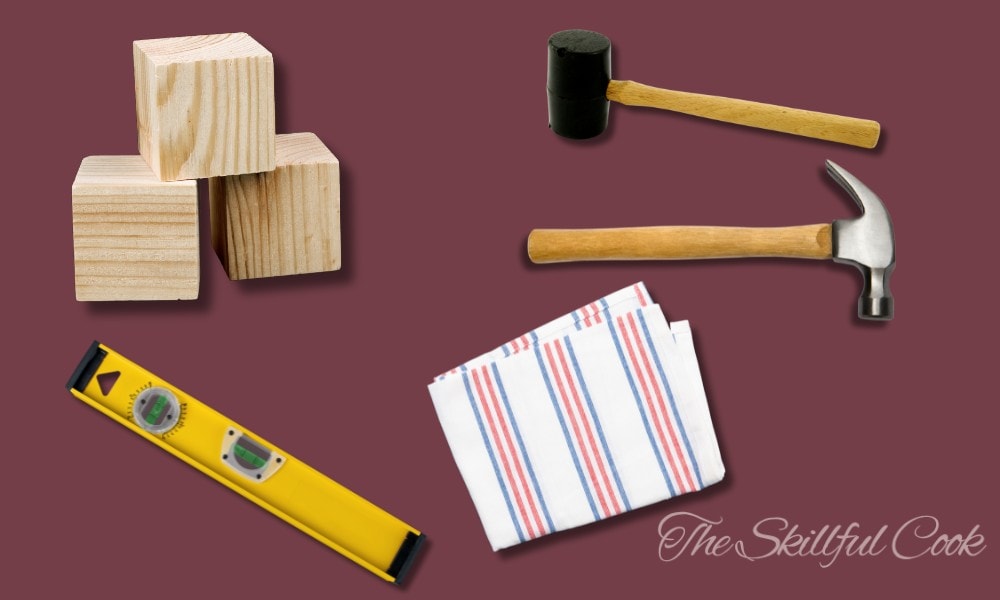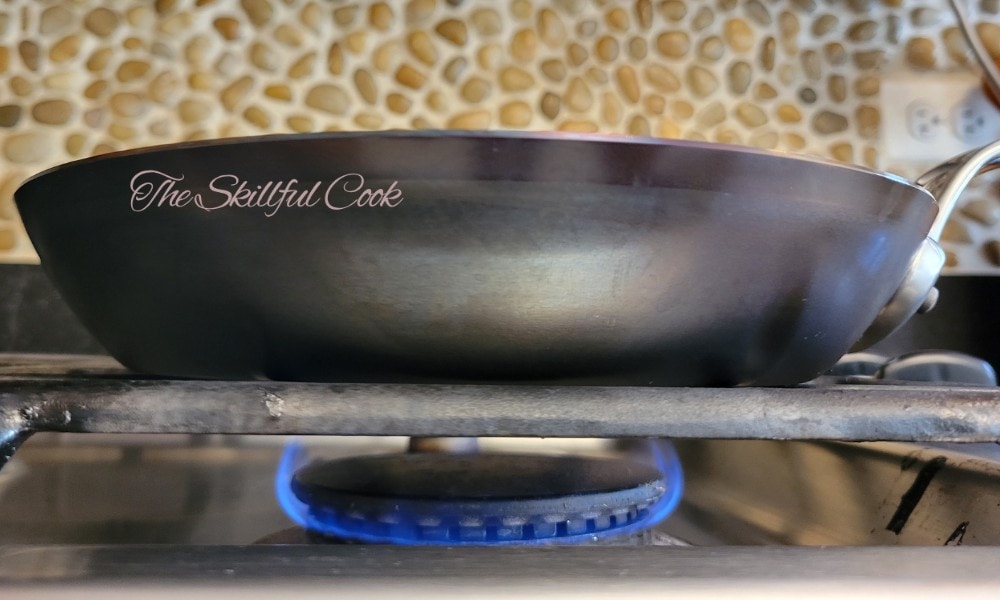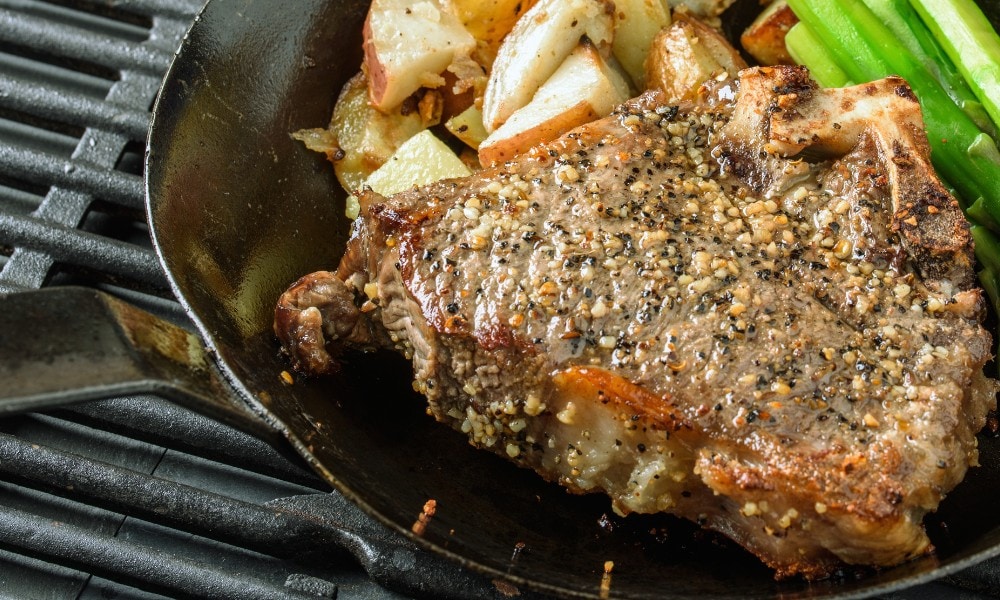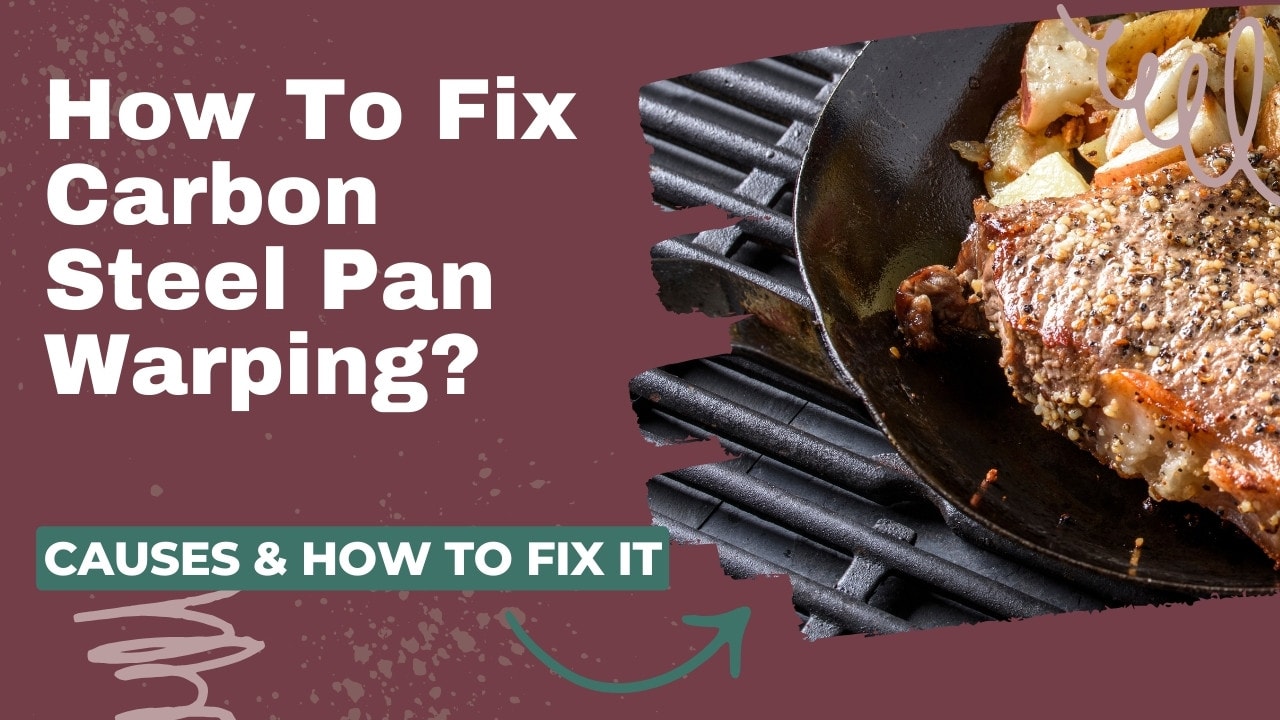The possibility of your carbon steel skillet warping may be the last thing that comes to your mind when purchasing your glossy new skillet. After all, this material is praised for being durable and resistant to abuse!
But a quick search will show you hundreds of disappointed users whose beloved carbon steel pan warped – often the first time on the stove! Does this mean your pan is ruined? And how can you prevent it from happening at all?
Carbon Steel Pan Warping – Can You Still Fix it?
Yes, you can fix a warped carbon steel pan – though you may not be able to restore it to its factory condition. Here’s how: Heat the pan to make it more malleable. Then use pressure or hammering to flatten the warped areas.
It won’t be perfect, but if you follow the steps below, you can definitely make your pan usable again.
What You Will Need
Fixing a warped carbon steel pan doesn’t require much equipment or preparation. My favorite method for unwarping a pan uses a technical principle called annealing. It involves heating a piece of metal until it softens, so you can undo the damage. It’s quick and safe to do at home if you use proper caution.
You need the following items:

How to Fix Warped Carbon Steel Pans Step-By-Step
Now, grab your pan and get down to work.
1. Prepare Your Workspace
Since the unwarping process involves heat and hammering, you want a solid and fixed space to work on. Avoid using the countertop or tile or wooden floors since hammering can damage them.
Working outside or on a garage floor or an old solid worktable may be best. Lay a towel down to protect the surface from heat and hammering.
2. Heat the Warped Pan
Put the pan on the stove and heat it for a few minutes. Use a gas stove for best results. Induction ranges aren’t suitable for this job since they give you less control over the heating process. Plus, there’s a higher chance that you get hot and cold spots and an unevenly heated pan. A gas stove will heat your pan more evenly.

Avoid high temperatures. Let the pan warm up over medium heat for a few minutes.
3. Start Hammering
Put the pan on the towel and grab it with an oven mitt since it’s hot. If the pan is warped inward with a concave bend, put the pan upside down. Otherwise, put it on the towel the way you put it on the stove for cooking.
Place the second towel on the pan’s warped surface, making sure it covers the pan’s bottom completely.
Then, put the wooden plank on the towel. This way, you prevent the pan bottom’s inner and outer surfaces from scratching.
After everything is set firmly in place, start hammering. Hit the plank with the hammer. Start with gentle hits to ensure you’re not overdoing things. If you don’t see any improvement, you can hammer harder. Remember, with this method, you’re not hitting the pan directly – you’ll be hitting the plank.
4. Inspect Constantly
Stop and check the pan’s surface after every few hits to ensure the pan doesn’t warp in the other direction. Place the pan on a flat surface or use your level to check how things are going.
If the pan has cooled down, heat it up again and repeat the hammering until you get an even surface.
Alternative Methods to Unwarp a Carbon Steel Pan
Although the above method has worked for many people, it’s not the only one.
You can hammer the pan’s surface without using a wood plank. That’s ideal for slightly warped pans that can flatten out with a few gentle hits. But a wood plank can prevent scratches and dents in your pan.
There’s an alternative method that doesn’t involve hammering. You can use it if you’re afraid of further damaging your pan.
For this method, you need a heat-safe heavy weight like metal gym weights that fit inside the pan:
- Put the weight in the pan if it’s warped outward. If it’s warped inward, turn the pan upside down and put the weight on top.
- Put the pan on low heat in the oven.
- Wait for a couple of hours until the heat and the weight do their jobs.
- Use extreme caution when removing the pan and weight from the oven, since they may be heavy and hot.
Heat makes the metal soft and workable, while the weight pushes the warped metal back into place.
This method can take longer but it’s easier and may be safer. You can just leave the pan in the oven to gradually unwarp.
Is a Carbon Steel Pan Ruined if It Warps?
A warped carbon steel pan isn’t totally ruined. You can still use it for cooking. But it won’t cook as evenly anymore, especially on cooktops that require cookware with completely flat bottoms. If you have an induction range or a glass-top stove, a warped pan may not conduct heat evenly on it.

You may also experience issues with the food inside the pan. Since warped pans don’t have a flat surface, ingredients or oil can pool inside the pan.
Finally, warped pans can increase the chances of accidents in the kitchen. The bowed bottom of the pan may spin, making the pan dangerous to use. Please avoid using a warped pan on a glass or induction stove, for safety reasons.
How Do You Keep a Carbon Steel Pan From Warping?
Cookware usually warps because of intense or uneven heating. When cookware —and not just carbon steel— is heated too quickly, the metal expands and can distort the cookware. So bring your pans up to temperature gradually, starting on lower heat settings and working your way up. This is a good practice with all kinds of cookware.
Be Super Cautious with Induction Ranges
Most warped carbon steel pans are the work of induction ranges. Because induction ranges generate heat using magnetism, they only heat the part of the pan that’s in full contact with the range. When one part of the pan is hot and the other is cold, the chances of warping increase.
You can use carbon steel pans on induction, but you need to be extra careful. Follow these tips to prevent warping your pan:
- Make sure the bottom of your pan is exactly the same size as the cooktop’s burner. Even if the burner is smaller by one inch, you’ll experience uneven heating. Check the actual size of the coil beneath the glass surface – it may not be the same diameter as the marking on the glass.
- Take your time when cooking in carbon steel. Account for the heating time when cooking so that you don’t need to crank up the heat from the beginning. Start with a low setting to prevent sudden temperature spikes.
Avoid Thermal Shock
Drastic changes in the pan’s temperature can warp its surface. When you’re done cooking, remove the pan from the cooktop’s surface and let it cool down slowly.
Never rinse a hot pan in cold water. This thermal shock can damage any cookware, especially carbon steel. Let cookware cool completely before washing it.
Use a Heat Diffuser
Regardless of your cooktop type, you can use a heat diffuser to ensure even heating. Heat diffusers are highly conductive aluminum sheets that spread the heat out across a pan. This helps make sure that the whole surface of the pan comes to temperature more gradually and evenly, preventing hot spots.
What to Look for in a Good Carbon Steel Pan
Carbon steel is generally durable, no matter the brand, thanks to its high iron content. You can get a lifetime of everyday use out of any carbon steel pan it if you handle it with care.
Still, some carbon steel designs and products are more likely to warp than others. Here’s how to find a pan that’s less prone to warping.
Conclusion
Carbon steel pans may warp if they experience sudden temperature changes. While a warped pan isn’t completely ruined, you won’t get the same functionality out of it as a flat-bottomed pan.
You can salvage your pan to a large degree by heating and gently hammering it. It may not turn out as good as new, but you can still get decent use out of it.
Have you ever fixed a warped carbon steel pan? Please share your experience with us!









